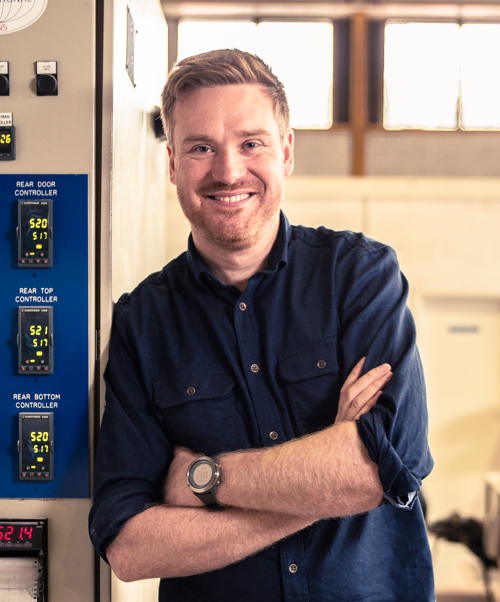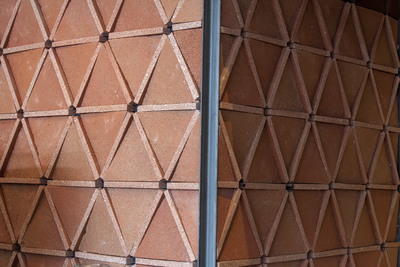Circularity Champion Dr Alasdair Bremner is one of the founders of Alusid, who makes beautiful sustainable surfaces from recycled materials. A materials expert, he is also a yogi and a fantastic thinker on the Circular Economy. We chatted to him about sustainable manufacturing, his favourite Alusid projects and how to engage architects and designers in productive conversations about sustainability…
What does Alusid do?
Alusid’s technology transforms hard-to-dispose-of ceramic and glass wastes into a variety of sustainable and attractive architectural surfaces.
How did Alusid begin?
Alusid was born out of a project at the University of Central Lancashire working with Professor David Binns called The Aesthetic of Waste, which considered the possibilities of low-value materials destined for landfill and whether they could be transformed into beautiful, high-end products for the architectural and interiors markets.

We were later granted funding from the Arts and Humanities Research Council (AHRC), which helped to turn our idea into a reality. Alusid was spun out in 2015 with the help of Frontier IP in raising equity funding.
What were the first waste materials you worked with?
This was partly driven by the products we were using and the process we had. We were trying to find materials, in the first instance, that were readily available with plentiful supply. But, importantly, we needed materials that were reasonably standard, so they wouldn’t change over time. This helps us combat one of the major problems of manufacturing using recycled materials.
What steps do you take to ensure that your manufacturing process is sustainable?
We have various internal steps we take beyond the use of almost 100% recycled materials. We have a water filtering and recovery system. We make use of as much of our off-cuts and processing waste as possible. Our kilns are all highly efficient and run on electricity. Ultimately, we need to increase the scale at which we make products because this will unlock a large proportion of the energy and environmental benefits.
What is your favourite Alusid project?
Nando’s HQ – London. We were involved in this project from the very start working with the architect to develop a triangular profiled tile that sloped from one side to the other. It was a very interesting design challenge but also a manufacturing challenge against a tight deadline.
How can we engage architects and designers in the circular economy and circular products?
We have found that architects and designers are pretty engaged already. As with everything, cost plays it’s part and so it is more important that clients are engaged more directly. I think that circular economy engagement has to happen much earlier in the process to be integrated and successful. So perhaps additional incentives beyond BREAM/LEED etc need to be considered throughout the built environment to help foster that early engagement with clients.

Nando’s headquarters, London

If you could hire anyone in the world to join Alusid who would you hire?
Renzo Piano [Italian architect who designed the Pompidou Centre in Paris and the Shard in London]

Some of Alusid’s products
If you were in charge of the UK, what 3 things would you do for the environment?
- Increase the amount of renewable electricity generation: solar wind and tidal
- Introduce a congestion charge to all cities in the UK and reduce car usage by encouraging more cycling and increasing spending on public transport
- Introduce financial incentives for designers and manufacturers to make products that can be separated easily to enable recycling
Any exciting projects in the pipeline?
Our most important project is the scale up of our manufacturing capacity using sub-contractors in Spain. This will enable us to unlock some of the energy savings mentioned earlier. Compared to like-for-like wall tiles, our estimates put the total energy saved at 35% and the water saved at over 75%.
When are you happiest?
I started doing yoga to help with a bad back; originally it was recommended to me by my doctor. I started to help my back but now I really enjoy the meditative aspects of it.

